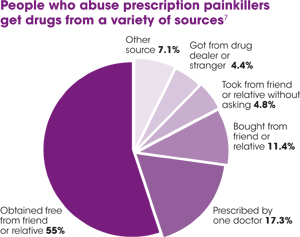Deaths from Prescription Painkillers Triple in 20 Years – What’s Going On?
This is the real war on drugs

The deaths of Philip Seymour Hoffman and Heath Ledger may have grabbed headlines, but there is a far larger tragedy behind America’s recreational painkiller epidemic. Deaths from prescription painkillers have more than tripled in the last 20 years, while drug overdose is now the leading cause of accidental death in the United States.
These deaths are not the consequences of poverty cycles or criminal gangs; they are a consequence of our country’s dysfunctional health system. This particular disease is almost unique to the US, with causes that lie in the very institutions that should have our best interests at heart.
Almost all the opioids taken recreationally originate from a legitimate prescription from a legitimate doctor. They are not bought on the street. They are, by and large, not bought online, either. They are not sourced from pharmacy heists or other criminal activity. Painkillers come from friends and family, legally in possession of them thanks to a culture that has normalized the use of powerful painkillers to the extent that 10.43% of 18-25 year olds have used prescription pain relievers recreationally.
The question is not so much why do kids use prescription drugs – kids have always experimented with drugs – but why prescription drugs in particular? How come they are so easily accessible?
Over-Prescription
How do kids get hold of Valium? Oxycontin? One way is by raiding their mother’s medicine cabinet. It starts with a legitimate prescription, and when the pain goes away, mom likes to keep a few around.
The truth is that doctors are over prescribing. The number of prescriptions for opioids has risen from around 76 million in 1991 to nearly 207 million in 2013. The US is easily the largest consumer globally, accounting for nearly 100% of total world hydrocodone (e.g. Vicodin) use and 81% for oxycodone.
Read: 16 of Nature’s Best Natural Painkillers
Needless to say, not all doctors are at fault. It’s usually confined to a relative handful in an area. And there is a particularly high concentration of over prescription amongst doctors who work alone, whose work – including their prescriptions – is not peer reviewed. Over-prescription is permitted by an under-regulated health system.
But why are they so ready to hand them out? Escalation like this isn’t the result of a few overzealous doctors.
Direct to Consumer Advertising
America is one of only two countries in the world to allow direct-to-consumer advertising of prescription drugs. Other than New Zealand, you will never see an advert, in any form, anywhere else on Earth for drugs you can’t buy over the counter.
The result is patients going to their doctor, specifically asking for a particular drug. The industry defends the practice as one of giving information. But as Dr. Dee Mangin, associate professor at the Christchurch School of Medicine and Health Sciences, New Zealand, puts it: “The truth is direct-to-consumer advertising is used to drive choice rather than inform it.”
As with any advertising, it’s being used to create demand rather than simply aid consumers into making informed choices. Dr. Manging continues: “In an era of shared decision-making, it’s much more likely general practitioners will just do what the patient asks.”
The Business of Health
And why wouldn’t a doctor do as their patient asks? We have a medical system that treats healthcare as a business. When I go see my doctor, I go as a patient, yes, but also as a customer. And the customer is always right. If my doctor won’t give me what I want, maybe I’ll go to one that will. Even if not consciously, financial concern may trump medical concern.
Doctors are under pressure from suppliers as well. Pharmaceutical companies aren’t in the business of handing out drugs for those who need them. They are in the business of selling them, and they sell them through doctors, pressuring them to supply particular drugs – the drugs they’re advertising directly to consumers (patients).
When the FDA loosened regulations requiring a full listing of side effects in direct-to-consumer advertising in 1985, prescriptions began to skyrocket. And as they did, accidental drug deaths did too – having tripled since 1990. In 2013, there were 43,982 drug overdose deaths in the United States, 51.8% of those (22,767) were from pharmaceuticals.
Prescription Culture
The up-shot is this, by creating and allowing a loosely regulated healthcare system that treats medicine as a business and allows direct-to-consumer advertising, not only are prescription pills more readily available, but their use is normalized.
Of course this doesn’t only happen in America. But it happens all over the globe and a lot more countries. And only because we let it.
Follow us: @naturalsociety on Twitter | NaturalSociety on Facebook


